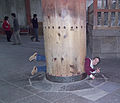Tōdai-ji

Tōdai-ji (東大寺), the Eastern Great Temple, is a Buddhist temple in Nara, Japan. Reputedly the largest wooden building in the world, it houses a giant statue of the Buddha Vairocana (Jp. Dainichi; it means 'Buddha that shines throughout the world like the sun'), known in Japanese simply as the Daibutsu (大仏, "great Buddha"). The temple also serves as the Japanese headquarters of the Kegon school of Buddhism. Sika Deer, themselves officially protected as National Treasures and regarded as messengers of the gods by Shinto, roam the grounds freely and are not afraid of humans.
History
During the Tempyō period, people suffered from disasters and epidemics. In 743, Emperor Shōmu issued a law which stated that the people should make a Buddha to protect themselves. He believed Buddha's power could help the people. 420,000 people contributed and 2,180,000 people worked to build it. The Great Buddha itself was designed by Kuninaka-no-muraji Kimimaro whose grandfather was an immigrant from the Korean Baekje Kingdom. According to legend, nearly 2,600,000 in total helped construct the Buddha at that time; this number equates to nearly the half of the people in Japan at that time and is probably exaggerated. The temple was established in 745[1] and the Buddha was completed in 751, having consumed most of Japan's bronze production for several years and leaving the country almost bankrupt. The statue has been recast several times since for various reasons including earthquake damage, and the temple rebuilt twice after fire. The current hands of the statue were made in the Momoyama Period (1568-1615), and the head was made in the Edo Period (1615-1867). The current building finished in 1709 although immense is actually 30% smaller than its predecessor. The original complex also contained two 100 m pagodas, probably the tallest buildings in the world at the time behind the pyramids. These were destroyed by earthquake.
Tōdai-ji was the provincial temple of Yamato Province and the head of all the provincial temples. The Shōsōin was its storehouse, and now contains many artifacts from the Tempyo period of Japanese history.

On May 20, 1994, the international music festival The Great Music Experience was held at Tōdai-ji, supported by the UNESCO. Among other artists were the Tokyo New Philharmonic Orchestra, X Japan, INXS, Bon Jovi, Bob Dylan, Tomoyasu Hotei, Roger Taylor, classic Japanese drummers, and a Buddhist monk choir. The event was broadcast on May 22 and May 23, 1994, in 55 countries all over the world.
The size of the Buddha
- Height : 14.98 meters
- Face : 5.33 meters
- Eyes : 1.02 meters
- Nose : 0.5 meter
- Ears : 2.54 meters
- Weight : 500 metric tonnes
Trivia
- One of the supporting posts in the Great Buddha Hall has a hole that has been bored through the base (see photo below in "Additional Images" Section). Children try to pass through it and legend has it that if one can pass through it one will be blessed with enlightenment.
- The current hands of the statue were made in the Momoyama period (1568-1615).
- The current head was made in the Edo period (1615-1867).
- The wooden structure was burned in both 1180 and 1567. The current building, like the head, was built in the Edo period.
- The width of the current building is approximately 33% smaller than that of the original structure.
Additional Images
-
Main gate to Tōdai-ji
-
View of Main Hall with main entrance altar in foreground.
-
Daibutsu at Tōdai-ji with caretaker at its base
-
Statuette from grounds of Tōdai-ji
-
The Daibutsu from another angle
-
A visitor passes through a hole in a pillar
See also
External links
- The Ancient Capital of Nara and the Old Temple Tōdai-ji
- Tōdai-ji - Oriental Architecture
- Tōdai-ji photos at PHOTOGUIDE.JP
34°41′21″N 135°50′23″E / 34.68917°N 135.83972°E Template:Buddhism2




